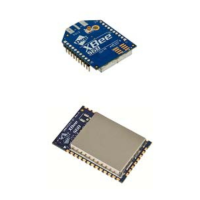XBee® Wi-Fi RF Modules
© 2013 Digi International, Inc. 31
Serial Interface Protocols
The XBee modules support both transparent and API (Application Programming
Interface) serial interfaces.
Transparent Operation
When operating in transparent mode, the modules act as a serial line replacement. All
UART data received is queued up for RF transmission. When RF data is received, the
data is sent out through the UART. The module configuration parameters are configured
using the AT command mode interface. Please note that transparent operation is not
an option when using SPI.
Data is buffered in the serial receive buffer until one of the following causes the data to
be packetized and transmitted:
• No serial characters are received for the amount of time determined by the RO
parameter. If RO is zero, data is packetized as soon as it is received, without
delay. If RO is non-zero, the data is packetized after RO character times of no
transitions on the DIN pin. However, if the time required for RO characters is
less than 100 microseconds, then DIN must still be idle for at least 100
microseconds, which is the minimal idle time required for packetizing packets at
any baud rate.
• The Command Mode Sequence (GT + CC + GT) is received. Any character
buffered in the serial receive buffer before the sequence is packetized and
transmitted before command mode is entered.
• The maximum number of characters that will fit in an RF packet is received.
API Operation
API operation is an alternative to transparent operation. The frame-based API extends
the level to which a host application can interact with the networking capabilities of the
module. When in API mode, all data entering and leaving the UART or SPI is contained in
frames that define operations or events within the module.
Transmit Data Frames (received through the DIN or SPI_MOSI pin) include:
• RF Transmit Data Frame
• Local commands (equivalent to AT commands)
• Remote commands to be sent to another radio
Receive Data Frames (sent out the DOUT or SPI_MISO pin) include:
• RF-received data frames
• Local command responses
• Remote command responses
• I/O samples from a remote radio
• Event notifications such as transmission status, reset, associate, disassociate,
etc.

